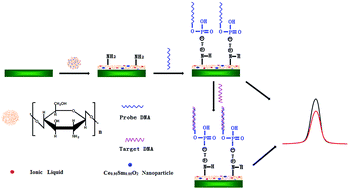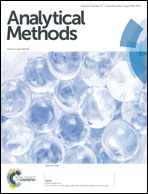A shell-like Sm-doped CeO2 nanostructure based electrochemical DNA biosensor for breast cancer gene sequence detection†
Abstract
Samarium doped cerium dioxide (CSO) nanostructures possessing a shell-like morphology were synthesised by a simple hydrothermal method. A novel nanocomposite membrane, comprising of CSO nanostructures, chitosan (CH) and a room temperature ionic liquid (RTIL) was deposited onto an indium-tin oxide (ITO) electrode for developing a DNA biosensor related to the breast cancer gene. The properties of the CSO and nano-composite membrane were studied by thermogravimetry (TG), X-ray diffraction (XRD), energy dispersive spectroscopy (EDS), scanning electron microscopy (SEM), cyclic voltammetry (CV) and electrochemical impedance spectroscopy (EIS). The hybridization capacity of the DNA biosensor was studied by differential pulse voltammetry (DPV) using [Fe(CN)6]3−/4− as an indicator. Under optimal conditions, the fabricated DNA biosensor could quantify a wide range of target DNA concentrations over the range of 1 × 10−13 to 1 × 10−6 M with good linearity (R = 0.9981) and a low detection limit of 1.56 × 10−14 M (3σ). Results showed that the fabricated shell-like CSO nanostructures and RTIL could enhance the electrical conductivity synergistically, which has great potential application in sensitive electrochemical biosensors.


 Please wait while we load your content...
Please wait while we load your content...